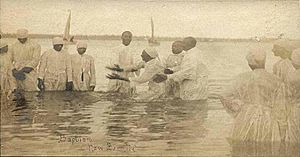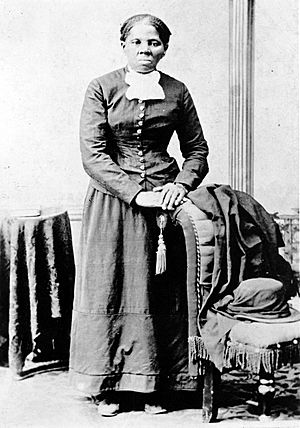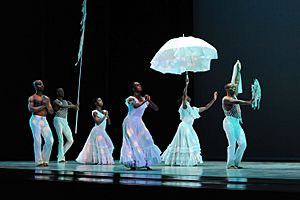Wade in the Water facts for kids
Quick facts for kids "Wade in the Water" |
|
|---|---|

River baptism in North Carolina c. 1910
|
|
| Song | |
| Published | 1901 New Jubilee Songs |
| Genre | Spiritual |
| Songwriter(s) | Unknown |
"Wade in the Water" is a famous spiritual song. Spirituals are a type of music first sung by African Americans who were enslaved. The words to "Wade in the Water" were first shared in a book in 1901. This book was called New Jubilee Songs as Sung by the Fisk Jubilee Singers. It was put together by Frederick J. Work and his brother, John Wesley Work Jr.. John Work Jr. was a teacher at Fisk University, a historically black college in Nashville, Tennessee.
John Work Jr. spent 30 years gathering and sharing these important songs. He also directed the Fisk Jubilee Quartet. The first time "Wade in the Water" was recorded for sale was in 1925. The Sunset Four Jubilee Singers performed it. W. E. B. Du Bois, a famous writer, called these types of songs "Sorrow Songs." "Wade in the Water" is also linked to the songs of the Underground Railroad.
Contents
The Fisk Jubilee Singers
John Wesley Work Jr. (1871–1925) worked at Fisk University for 30 years. He collected and shared the "jubilee songs" of the original Fisk Jubilee Singers. These singers were an a cappella (singing without instruments) student choir from Fisk University. They helped introduce spirituals to many people.
In 1901, Work Jr. and his brother, Frederick J. Work, published New Jubilee Songs. This book included "Wade in the Water." The Fisk singers led by John Work Jr. were known for their beautiful voices. They often used a "solo call and unison response" style.
Ella Sheppard was one of the first Fisk Jubilee Singers. She explained that slave songs were not sung by the group at first. This was because the songs were very special to their parents. They used them for religious worship. Ella said that over time, they learned to appreciate the beauty of these songs.
Frederick Douglass, a former enslaved person, said these songs told a sad story. He felt they were a "prayer to God for deliverance from chains." These songs made him hate slavery even more. In his 1903 book, The Souls of Black Folk, W. E. B. Du Bois wrote about "Sorrow Songs." He called them African America's "greatest gift."
The original Fisk Jubilee Singers toured to raise money for Fisk University. Their first tour was on October 6, 1871. At first, audiences were small. But by 1872, they performed at a big festival in Boston. They even sang at the White House. In 1873, they toured Europe.
The original group stopped performing in 1878. But in 1890, Ella Sheppard Moore returned to Fisk. She began to train new jubilee singers, including Work Jr. In 1899, the university wanted a mixed choir to tour. This choir became too expensive. So, John Work Jr.'s male quartet took over. This quartet became very popular. They made many best-selling recordings between 1909 and 1916.
In 1925, the year Work Jr. died, the Sunset Four Jubilee Singers made the first commercial recording of the song. It was released by Paramount Records.
Song Lyrics
The words to "Wade in the Water" were first printed in 1901. They appeared in the book New Jubilee Songs as Sung by the Fisk Jubilee Singers.
Wade in the water
Wade in the water, children
Wade in the water
God's gonna trouble the water
Over the years, different versions of the lyrics have been published. For example, a 1926 version was called "God's A-gwineter Trouble De Water." Its first line was "Wade in de water, children." A 1956 version from Kentucky started with "Oh see that man dressed in white."
A 1930s version from Alabama had the title "God Gonna Trouble the Water." Its first line was, "I'm er wading, I'm er wading in the water, chillun." In 1960, a book called Folk Songs of North America had the first line as "'Member one thing an' it's certainly sho.'"
Many other books have also included different versions of the song. These show how the lyrics changed over time and in different places.
Songs of the Underground Railroad

"Wade in the Water" is believed to be one of the songs used with the Underground Railroad. The Underground Railroad was a secret network. It helped enslaved people in the United States escape to freedom.
It is thought that Harriet Tubman used this song. She made 13 trips to the South. She helped more than 70 people escape slavery. She might have used the song to tell escaping slaves to go into the water. This would hide their scent from dogs used by slave catchers. Dogs could not follow a trail through water.
In 1993, Arthur C. Jones wrote a book called Wade in the Water: the wisdom of the spirituals. Jones is a professor at the University of Denver. He started "The Spirituals Project" in 1998. This project helps keep the music and lessons of spirituals alive. Jones explained that Harriet Tubman and others changed existing spirituals. They used them secretly to help people gain freedom.
In 2002, Maryland Public Television created a teaching guide. It was about the Underground Railroad. The guide explained that many slave songs had "secret meanings." They could be used to send messages. "Wade in the Water" was an example. It told slaves to enter the water to avoid being tracked by dogs.
The song was also part of a 1968 collection. This collection was called Freedom is a constant struggle: songs of the freedom movement.
Performances and Recordings
Many groups have recorded "Wade in the Water." The Sunset Four Jubilee Singers made a recording in 1925. Other groups like the Lincoln Four Quartette and Birmingham Jubilee Quartet also recorded it. The Empire Jubilee Quartet recorded the song in 1929.
In 1960, the Alvin Ailey American Dance Theater performed their famous ballet Revelations. A part of this ballet, "Take me to the Water," used the spiritual "Wade in the Water."
The Staple Singers performed their version of the song. It became an important part of the Civil Rights Movement in the United States.
Bob Dylan also performed the song in 1961. His version was likely based on The Staple Singers' performance. It was later released on a historic album. Folk singer Judy Henske sang it in the 1963 film "Hootenanny Hoot."
In 1966, the Ramsey Lewis Trio had a popular instrumental version. It reached number 19 on the Billboard Hot 100 music chart. In Canada, it reached number 32.
In 1967, Herb Alpert and Billy Preston also released instrumental versions. The melody of "Wade in the Water" was used for the 1988 hit song "Little Walter" by Tony! Toni! Toné!.
In 1996, Charlie Haden and Hank Jones released an album called "Steal Away." A reviewer said that Hank Jones played "Wade in the Water" with delicate improvisation.
The Fisk Jubilee Singers performed at the Apollo Theater in New York in 2000. They sang for high school students. When they added some modern gospel style to "Wade in the Water," the audience applauded.
Wade in the Water, Children is a 2008 documentary film. It was made by eighth-grade students in New Orleans. The film shows what life was like for children after Hurricane Katrina. The movie won an audience award at a film festival.
The Golden Gate Quartet's version of the song is on a 2009 album. This album is called Bad Seeds – Nick Cave: Roots & Collaborations.
On May 3, 2019, the Fisk Jubilee Singers sang "Wade In the Water" live. They performed at the Grand Ole Opry in Nashville, Tennessee.
In 2019, Tazewell Thompson created an a cappella musical called Jubilee. It honors the Fisk Jubilee Singers. The song "Wade in the Water" is used in a scene about a ship returning to America.
The song "Stand Up" from the 2019 movie Harriet mentions "wading through muddy waters." This line could be a nod to "Wade in the Water."
In February 2020, the album Trouble the Water was released. It features civil rights-themed music. This album includes "Wade in the Water" performed by Woody Lissauer.


